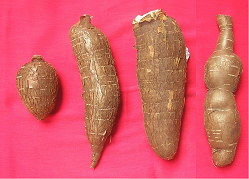
Tuber yield, morphology, and chemical properties variability of sweet cassava germplasm
Tinuk Sri Wahyuni(1), Kartika Noerwijati(2*)
(1) Indonesian Legumes and Tuber Crops Research Institute (BALITKABI) Jl. Raya Kendalpayak KM 8, PO BOX 66, Malang 65101, Indonesia
(2) Indonesian Legumes and Tuber Crops Research Institute (BALITKABI) Jl. Raya Kendalpayak KM 8, PO BOX 66, Malang 65101, Indonesia
(*) Corresponding Author
Abstract
Keywords
Full Text:
PDFReferences
Balai Penelitian Tanaman Aneka Kacang dan Umbi. (2017). Kebun percobaan. [online]. Available at: http://balitkabi.litbang.pertanian.go.id/profil/kebun-percobaan-2/. [Accessed 25 June 2020].
Chisenga, S.M., Workneh, T.S., Bultosa, G., and Laing, M. (2019). Proximate composition, cyanide contents, and particle size distribution of cassava flour from cassava varieties in Zambia. AIMS Agriculture and Food, 4(4), pp. 869–891.
Food and Agriculture Organization. (2013). Cassava, a 21st century crop. In Save and grow: cassava, a guide to sustainable production intensification. [Online]. Available at: http://www.fao.org/ag/save-and-grow/cassava/en/1/index.html [Accessed 25 June 2020].
Fukuda, W.M.G., Guevara, C.L., Kawuki, R., and Ferguson, M.E. (2010). Selected morphological and agronomic descriptors for the characterization of cassava. 1st ed., Ibadan: International Institute of Tropical Agriculture (IITA) Nigeria, pp. 19.
Hahn, S.K., Reynolds, L., and Egbunike, G.N. (1988). Cassava as livestock feed in Africa. Proceedings of the IITA/ILCA/University of Ibadan workshop on the potential utilization of cassava as livestock feed in Africa, pp. 159.
Indiati, S.W. (2012). Ketahanan varietas/klon ubikayu umur genjah terhadap tungau merah. Jurnal Penelitian Pertanian Tanaman Pangan, 31(1), pp. 53–59.
Juliano, B.O. (1971). A simplified assay for milled-rice amylose. Cereal Science Today, 16(10), pp. 334-340.
Laya, A., Koubala, B.B., Kouninki, H., and Nukenine, E.N. (2018). Effect of harvest period on the proximate composition and functional and sensory properties of gari produced from local and improved cassava (Manihot esculenta) varieties. International Journal of Food Science, 2018, pp. 1-15
Marais, J.P., de Wit, J.L., and Quicke, G.V. (1966). A critical examination of the Nelson-Somogyi method for the determination of reducing sugars. Analytical Biochemistry, 15(3), pp. 373–381.
Mullan, D.J. and Barrett-Lennard, E.G. (2010). Breeding crops for tolerance to salinity, waterlogging and inundation. In: M. P. Reynolds (Ed.), Climate Change and Crop Production. Wallingford, UK: CAB International, pp. 92–114.
Ndubuisi, N.D. and Chidiebere, A.C.U. (2018). Cyanide in cassava: A review. International Journal of Genomics and Data Mining, 2(1), pp. 1-10
Oshunsanya, O.S. and Nwosu, N.J. (2018). Soil-water-crop relationship: A case study of cassava in the tropics. Intech, tourism, 13. [online]. Available at: https://www.intechopen.com/books/advanced-biometric-technologies/liveness-detection-in-biometrics [Accessed 17 December 2020]
Sánchez, T., Dufour, D., Moreno, J.L., Pizarro, M., Aragón, I.J., Domínguez, M., and Ceballos, H. (2013). Changes in extended shelf life of cassava roots during storage in ambient conditions. Postharvest Biology and Technology, 86, pp. 520–528.
Teye, E., Asare, P., Amoah, R., and Tetteh, J. (2011). Determination of the dry matter content of cassava (Manihot esculenta, Crantz) tubers using specific gravity method. APRN Journal of Agricultural and Biological Science, 6(11), pp. 23–28.
Vieira, E.A., de Freitas Fialho, J., Faleiro, F.G., Bellon, G., da Fonseca, K. G., Carvalho, L.J. C.B., Silva, M.S., de Paula-Moraes, S.V., de Oliveira, C.M., and Denke, M.L. (2011). Characterization of sweet cassava accessions based on molecular, quantitative and qualitative data. Crop Breeding and Applied Biotechnology, 11(3), pp. 232–240.
Wyckhuys, K.A.G., Wongtiem, P., Rauf, A., Thancharoen, A., Heimpel, G.E., Le, N.T.T., Fanani, M.Z., Gurr, G.M., Lundgren, J.G., Burra, D.D., Palao, L.K., Hyman, G., Graziosi, I., Le, V.X., Cock, M.J.W., Tscharntke, T., Wratten, S.D., Nguyen, L.V., You, M., Lu, Y., Ketelaar, J.W., Georgen, G., and Neuenschwander, P. (2018). Continental-scale suppression of an invasive pest by a host-specific parasitoid underlines both environmental and economic benefits of arthropod biological control. PeerJ, 2018(10).
Yonis, B.O., Pino del Carpio, D., Wolfe, M., Jannink, J.L., Kulakow, P., and Rabbi, I. (2020). Improving root characterisation for genomic prediction in cassava. Scientific Reports, 10(1), pp. 1–12.
Article Metrics
Refbacks
- There are currently no refbacks.
Ilmu Pertanian (Agricultural Science) ISSN 0126-4214 (print), ISSN 2527-7162 (online) is published by Faculty of Agriculture Universitas Gadjah Mada collaboration with Perhimpunan Sarjana Pertanian Indonesia (PISPI) and licensed under a Creative Commons Attribution-ShareAlike 4.0 International License.














